Part 1
A Definitive Object, a Solidity of Purpose
“The plan appears to me very promising, and I hope, and that its success will further the amiable design of its formation––as a publication … which though so attractive to the Eye, and in some of their contributions, so touching to the heart, have always seemed to me as wanting a definitive object, a solidity of purpose…”
(Mary Sterndale to Mary-Anne Rawson, 28 February 1833)
The anti-slavery anthology The Bow in the Cloud, published in 1834, came with international aspirations. It was roughly an 8-year project, one that sought to bolster various abolitionist movements throughout the world. The making of the book encompassed the time when slavery had been abolished in the UK (and was still legal in the colonies), to when it was abolished in the colonies but still very much alive in many other parts of the world. It was initiated in 1826 by Mary-Anne Read, a young activist in Sheffield encouraged by the example of her parents, who were well-known philanthropists, to use literature to influence public opinion. Yet the project stalled, for reasons that are not yet known. By mid-1834, Mary-Anne, now married to George Rawson, and still living in Sheffield, had re-ignited the project and shepherded The Bow in the Cloud into publication with a major London publisher, Walford and Jackson.
Many of the figures in the anthology require more exploration: only about half of the contributors are in the Oxford Dictionary of National Biography or Wikipedia. Also, many of the existing entries on these contributors do not mention their abolitionism, or their literary contributions to this anthology. It is also no less significant that roughly half of the figures (including Rawson) appear in the sprawling painting by Benjamin Haydon commemorating the 1840 Anti-Slavery Convention in London, which you can see in the National Portrait Gallery in London. Notice that Rawson is prominently featured near the front (on the far right side, circled in red).
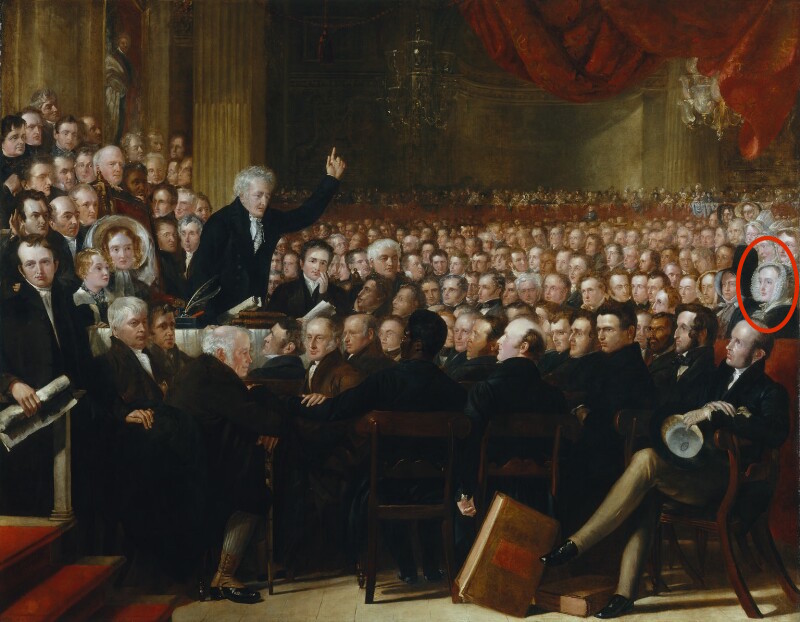
(Courtesy National Portrait Gallery, NPG 599.)
While searching for the Bow in the Cloud on Google Books, I got a result that erroneously lists the author of the book as Bonnie Barton (presumably an OCR error––a common metadata problem with Google Books––picking up the first contributor to the anthology, Bernard Barton). I have also found entries in WorldCat––and even in peer-reviewed scholarly works––mentioning Bonnie Barton’s Bow in the Cloud. This quasi-erasure of Rawson’s role in the making of this book exemplifies the amount of work that still needs to be done to recover the histories in our cultural archives.
Going beyond these oversights, the material contents surrounding the book’s publication have never been thoroughly investigated. Its editor, Mary-Anne Rawson, was a founding member of the Sheffield Ladies Anti-Slavery Society, one of the most radical abolitionist groups and one of the first to officially boycott plantation sugar and to call for universal abolition. This history of this text is crucial because the Bow in the Cloud is an early example of the politically-themed literary anthology, one which would be soon copied in the US. Its manuscript collection is significantly vast and revealing; particularly so for an anthology of this kind, with so many contributors, some of whom were not professional writers. Each submission to the anthology came with a covering letter (and some submissions have multiple letters spanning from 1826 to 1834) and some pieces also came with photographs, drawings, engravings of the authors, or newspaper clippings. The poems that Rawson chose to publish were also copied in her own hand, and several of those fair copies show evidence of her revisions to the pieces before she supplied a printer’s copy to Walford and Jackson.
The entire manuscript collection, housed at the John Rylands Library (Eng MSS 414-415), has just been digitised, as part of a digital humanities start-up grant that I received from the John Rylands Research Institute, University of Manchester, in 2018.1 The digital images of more than 600 surviving manuscripts total 818 high-resolution files which will soon be available––with extensive metadata of each item based on my study of the manuscripts––as open-access images on a IIIF manifest.2
What also requires exploration is a meditation on the nature of the enterprise itself: this is an anthology, edited by a pioneering woman with specific aims that were difficult to articulate, at a crucial time in history. How were these pieces solicited, who declined, which pieces were rejected, and which were eventually published? How were they received, edited, organized, and designed? How did this kind of book affect the publishing and literary culture of abolitionism in the United States? The surviving evidence now being brought out will give the best sense yet of this unique volume’s textual history. I am currently creating a digital edition and a network analysis to bring out more of these connections in this under-appreciated anthology.
***
The Bow in the Cloud was published in 1834 by Jackson and Walford, in St. Paul’s Churchyard, London. The firm was probably best known as the publisher of the nonconformist, progressive magazine Eclectic Review as well as many ecclesiastical books.
The book was sold for 12 shillings, which is about 50 GBP in today’s money. Put another way, it was about two days pay for a skilled tradesman, or about the cost of a week’s supply of butchered meat and tea. In other words, this was a middle-class product, on the edge of affordability.

The volume appears handsome: its foolscap octavo pages (at 6¾” x 4¼ “) were gilt on the edges and bound in turkey morocco with a gilded engraving on the cover. The publication’s advertisement pamphlet called attention to its quality, which is sort of true: while the goatskin-based binding is a sturdy, high-quality material, it was bound a bit too tightly, and the gilded pages were really an affectation of the publishing world that did not add significantly to the quality. The foolscap pages themselves were also small and fairly reflective of most publications of the time, so it was not an exceptional piece of craft.

The book is sizeable: it comes to 408 pages. In addition to Rawson’s Preface, it contains 95 pieces of poetry and prose.
The book’s frontispiece was designed by H. Corbould (that is, Edward Henry Corbould). Here is his original version of the etching that was printed before the book’s title page.
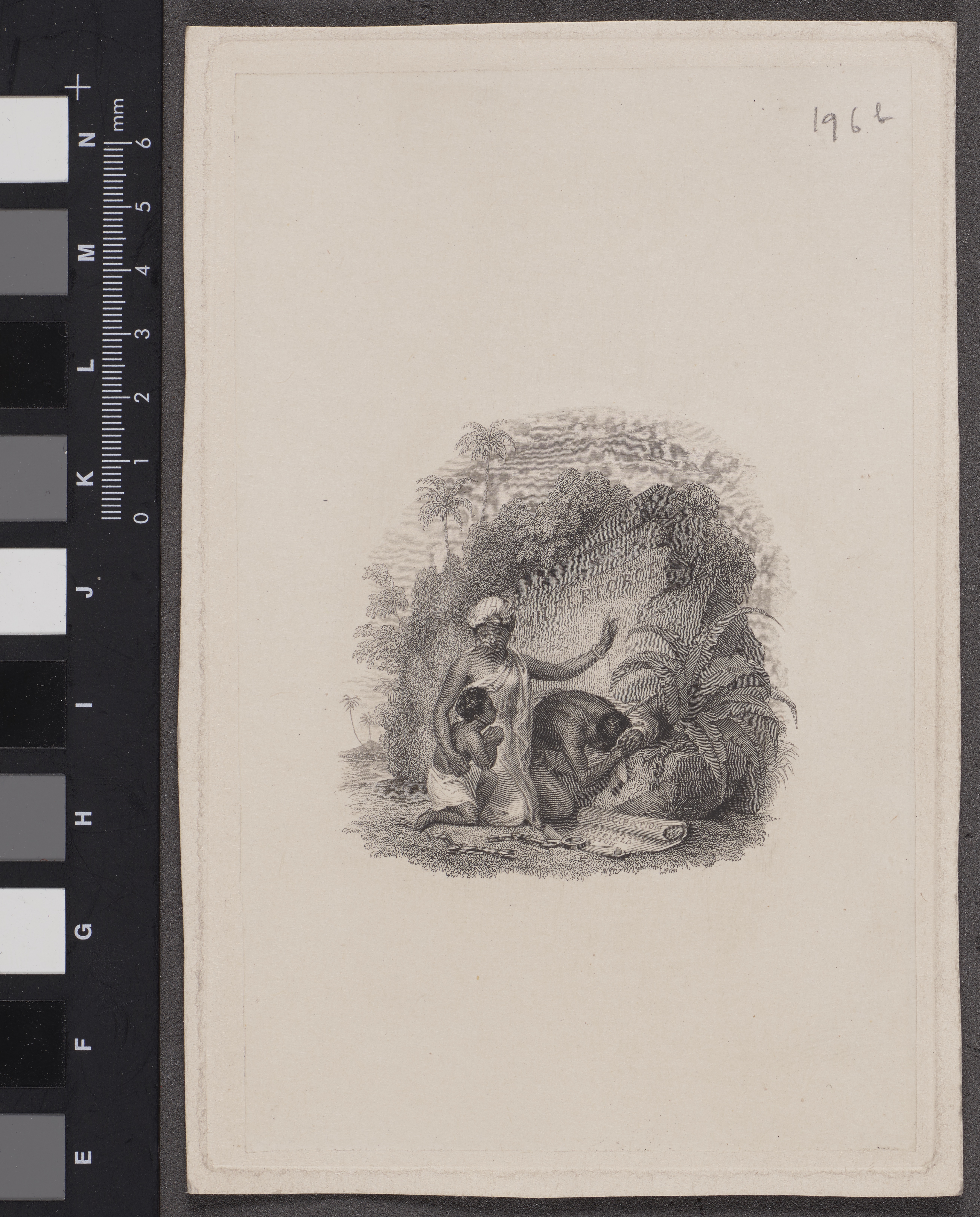
In 1833 the nineteen-year-old Corbould was at the beginning of a distinguished career as a book illustrator and watercolour artist. In the same year that The Bow in the Cloud was published, he received his first of several gold medals from the Society of Arts, and he later refined his literary appreciation by creating illustrated editions of Chaucer, Spenser, Shakespeare, and Tennyson. One of Corbould’s letters sent to the publishers Jackson and Walford even includes his fee for the illustration: 4 pounds 40.
But this was not the only illustration that could have been included in the book.
Ann (nee Taylor) Gilbert, the well-regarded children’s poet who co-wrote with her sister Jane Taylor, sent a poem that was published as “The Mother” (she is listed in the volume as ‘Mrs. Gilbert’). Her submission came with a small watercolour illustration that Rawson did not use.
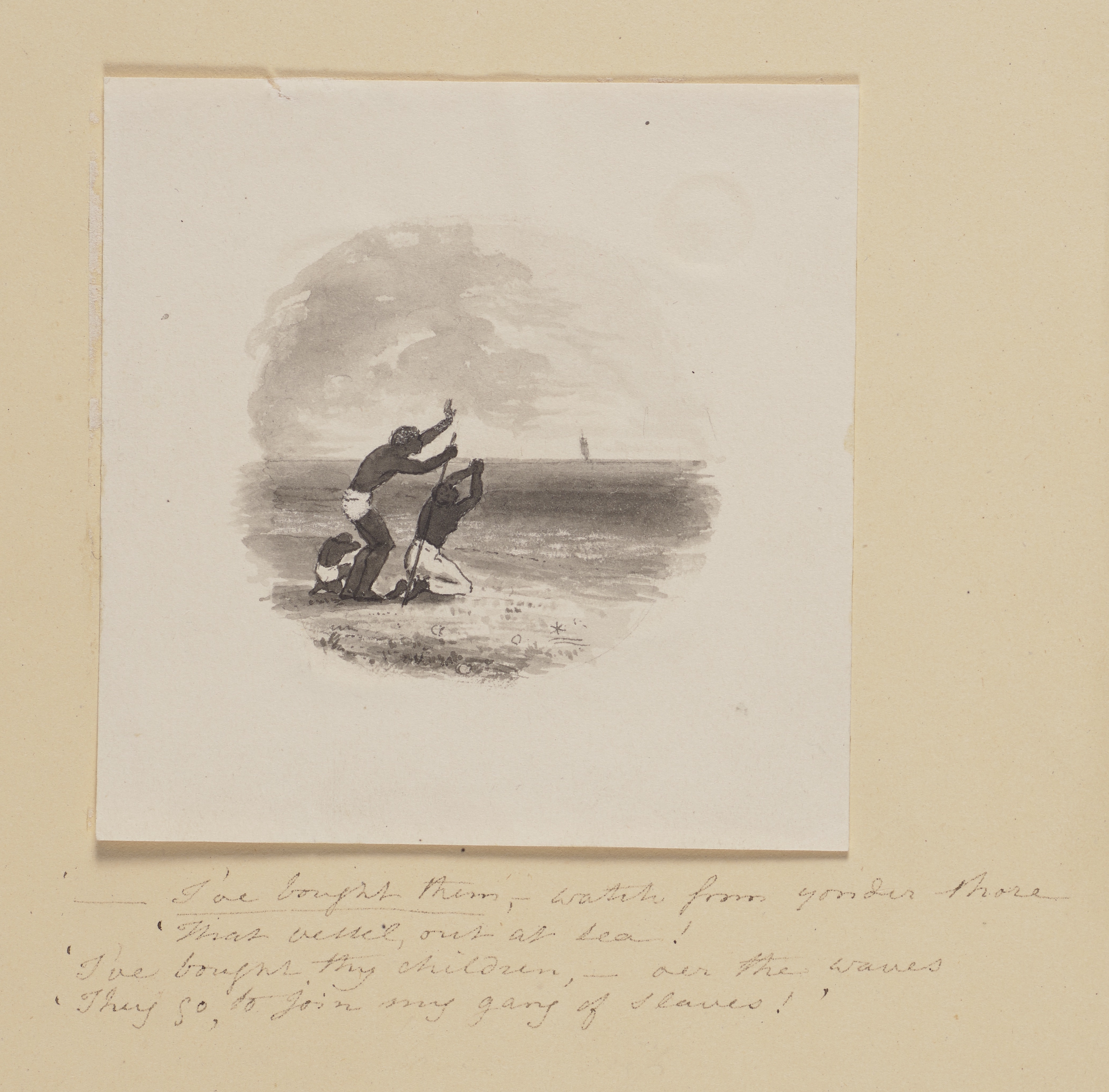
All three of Gilbert’s poems in the volume examine the pathos of shattered domesticity created by slavery, a voice that stands in contrast to what she is known for today.
Another pencil drawing by Mary Sterndale was to accompany her only published poem, “The Slave Ship”, but Rawson did not include it.
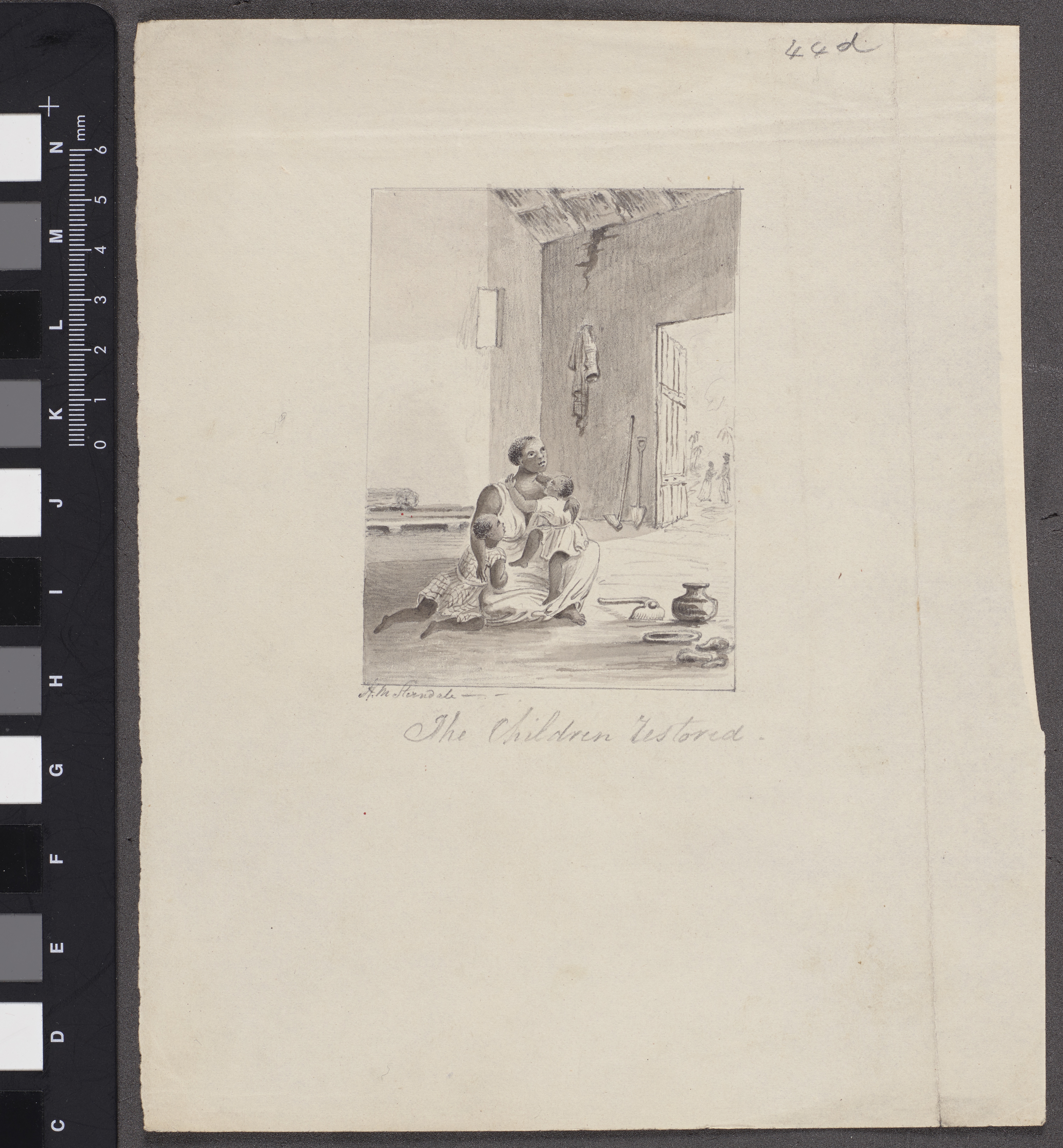
Here again is an image of the family that is intended to solicit sympathy.
These illustrations are unique examples of the wealth of textual and paratextual material in the collection, but the manuscript variations also offer several clues to Rawson’s process.
The collection includes two heavily revised drafts of her Preface. Each draft also includes unpublished notes. One of the goals of recovering this textual history is to produce a digital edition of The Bow in the Cloud, including not only unpublished manuscript material such as the covering letters, but also a genetic text showing the development of the texts that exist in multiple versions.
Here is a preview of the genetic editing tool, called TextLab, which I am using to mark-up transcriptions of the manuscripts in XML according to the standards of the Text Encoding Initiative. This markup identifies several useful attributes, including the date of the manuscript, who made what changes, and other information about those changes and the medium. It also matches the transcription to its location on the page image. Here is the opening of Rawson’s Preface in TextLab’s editing environment (in minimal TEI).
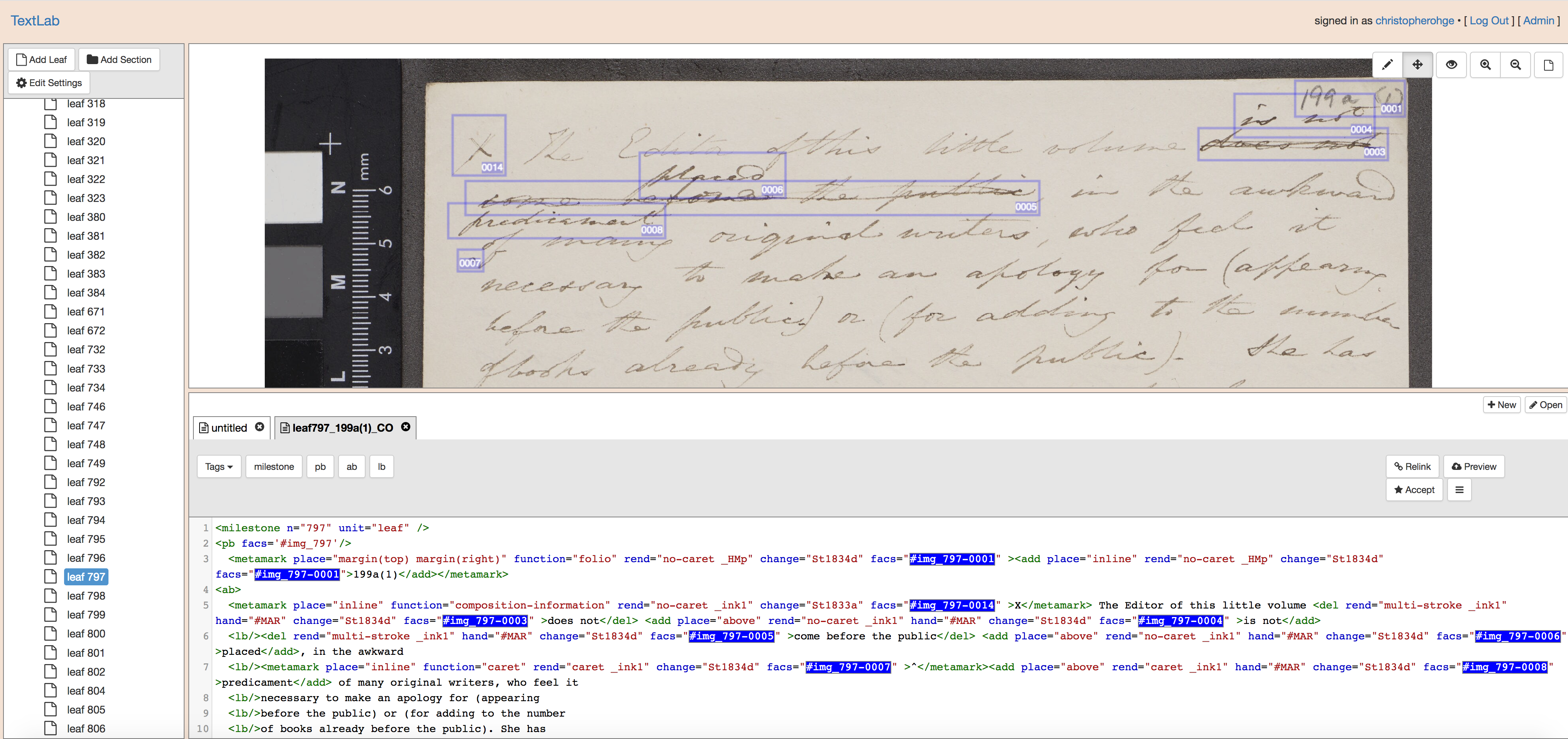
And this is how it is rendered in the diplomatic transcription interface.
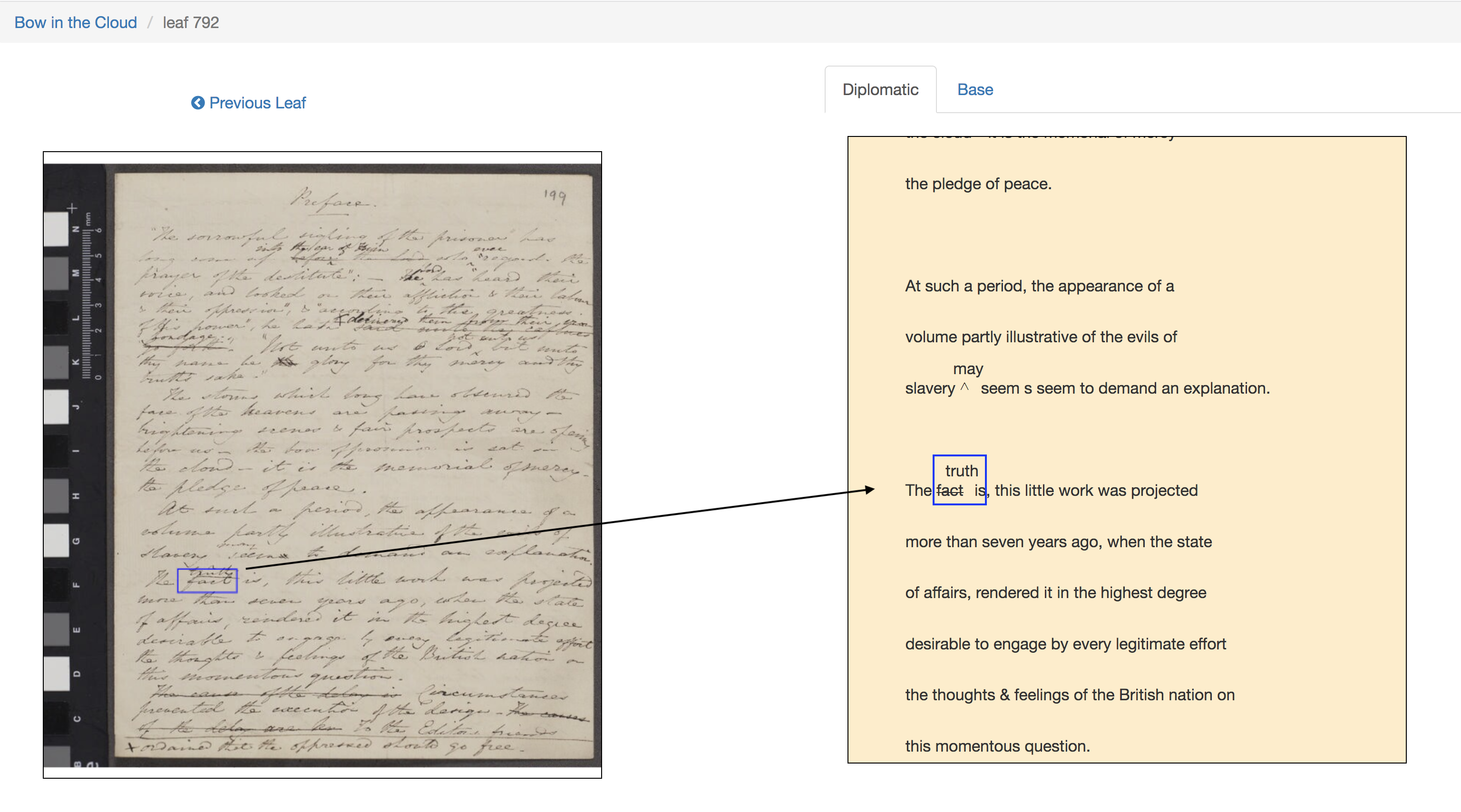
I am currently marking up all the manuscripts in the collection for a digital edition so that researchers will be able to analyse the stages of revision that preceded the publication. These encoded documents will consist not only of poem and prose fair copies (many of which were revised by Rawson), but also of the original submissions that were included with covering letters. Encoding of unpublished documents will also give researchers a better sense of the varieties of work that went into bringing this anthology to the public, as well as the connections between the documents that will form the basis of a network analysis.
One unpublished note from the Preface reveals Rawson’s desire to clearly justify her role before the public:
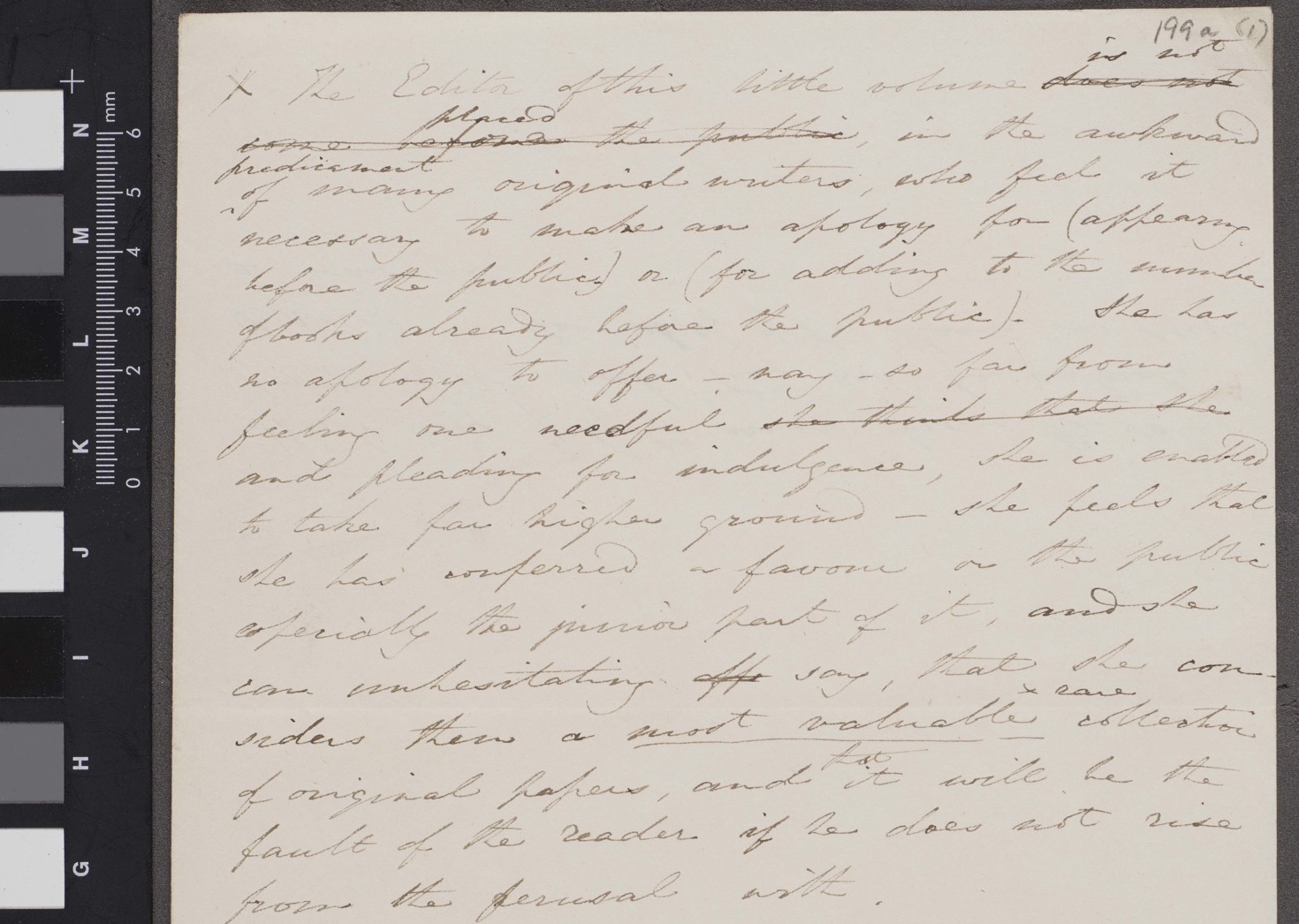
The Editor of this little volume is not placed in the awkward predicament of many original writers, who feel it necessary to make an apology for (appearing before the public) or (for adding to the number of books already before the public). She has no apology to offer––nay––so far from feeling one needful and pleading for indulgence, she is enabled to take far higher ground––she feels that she has conferred a favour on the public especially the junior part of it, and she can unhesitating say, that she considers them a most valuable & rare collection of original papers, and that it will be the fault of the reader if he does not rise from the perusal with.
Rawson chose not to sign her Preface in the published version, so her “role” was as an anonymous editor from Wincobank Hall, Sheffield. In fact, her name does not appear anywhere in the book.
Rawson also solicited advice from some of the volume’s contributors about the Preface and other contributors’ pieces. One such clue left in the manuscripts comes from the congregationalist minister J. W. H. Pritchard’s letter from 11 April 1834. It proves not only that he helped her edit some poems in the book, but that he also offered suggestions to Rawson’s preface, which were adopted. Pritchard wrote in one instance:
The sentence [in the Preface] might admit of a change of this kind “It would indeed have been delightful if every hand which has taken a prominent part [or been actively employed] in pulling down the prison house, & in striking off the fetters of the bondsmen, could have put &c”
That phrase, as it was published on page 5, adopted some of his suggestions: ‘It would indeed have been delightful if every hand which has been actively engaged in pulling down the prison-house, and striking off the fetters of the bondman, could have put a stone into the monument here erected upon its ruins, to tell posterity where it stood, the curses it contained, and how it fell’. This phrase is also not to be found in the two surviving drafts of the Preface. It is also clear that there was an additional printer’s copy of the Preface, which does not survive, because there are still notable differences between the the manuscripts in the collection and the published version. Her unpublished notes also show that she sent proof sheets to at least seven other readers––only some of whom had contributed to the book.
These hitherto undocumented details surrounding Rawson’s editing of the anthology show her as an active editor, organizer, and writer. They also reveal the extent to which she relied on her social network of anti-slavery activists, not just locally, through the Sheffield Ladies Anti-Slavery Society, but also in London and elsewhere.
In part 2 of this blog, I will go into some more detail about some of the contents of manuscript collection surrounding this fascinating anthology.
This is fascinating. Richard Cecil, whose letter of 1826 from Nottingham to Mary Anne Rawson encloses an article which may or may not have made it to the final book, is my great great grandfather. His wife, Salome, was the niece of Joseph Gilbert. I would love to see the publication once it is fully digitised.
Was Wincobank Hall, Sheffield, a school? I think my great grandmother, Mary Cecil (nee Taylor) might have been at school there.